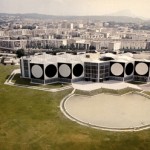There is a Vasarely museum in Budapest. Not really known, rather modest in terms of display, not easily accessible in terms of location. (I was there one month ago and would have appreciated if someone could have explained that: you first need to go by Hev underground from Margareta bridge to the third stop, at Arpad bridge. The building is at no. 6, Szentelek street.) However, it has some of the most valuable works produced by Victor Vasarely, and a full op-art experience that should not be missed when visiting Budapest.
Until then, Triennale di Bovisa in Milan presents on 27th of January 2008 a Victor Vasarely exhibition: “L’artista non ha che una scelta giusta: annularsi come persona in favore della sua opera e offrirla con amore all’umanita astratta.” (N.B. the artist may have a single correct choice: to vanish as individual in favour of his works, and to give it away to an abstract humanity). The curators of the exhibition, Andrea Busto and Cristiano Isnardi, propose through 200 works divided in 9 sections an unusual lecture of Vasarely’s artistic and cultural venture and of his role in the art history of the 20th century.
Victor Vasarely (Pecs, Hungary, 1906 – Paris, 1997) studied in Budapest where he is under Bauhaus school influence. Leaving for Paris in 1930, he goes in contact with the Abstract-Creation group; he works mostly on graphics during that time. Working exclusively in white and black, he starts to be more and more interested by optical and kinetic research. He tries various colours and optical illusions in different perspectives, becoming one of the main artists of the op-art trend.
Vasarely’s theory and poetics, placed between a maths experiment and a social utopia, carries an universal message in which the works of art may, through its aesthetics, improve the world. This idea has deeply influenced the visual arts in the past century, promoting the access of a wide audience to an aesthetic joy seen as means of enriching daily life. As expected, the first areas of work (due to their presence in peoples’ life) were design and architecture.
Therefore, there are 6 halls of the exhibiton dedicated to painting plus other 3 sections presenting original and less studied themes so far:
– Photo graphic representation as a species of photographic inventions in which drawing and collage are subject to a mechanic and photographic illustration, basically in white and black;
– programmes as projects to undertake graphic design works, in which it becomes obvious the artist’s effort for a computerized art and purely technical execution;
– the relationship with the architecture that applies Vasarely’s theory and poetics in this area. The main example is designing and building the Vasarely Foundation in Aix-en Provence, as a real “total works of art” in which the fusion between painting and architecture finds its most practical application. This section includes, among other projects of architectural integration of his artistic theories, interventions in Paris, Montpellier or other places in France. Well dated, these buildings remained simple experiments in history, a bizarre result of transposing visual concepts from graphics into architecture. Yet Vasarely’s studies on perceiving the perspective, the optical illusions and the geometrical compositions may easily be identified in the works of many generations of architects, and continue to be present in facades, drawings on pavement, interior design in contemporary architecture all over the world.


